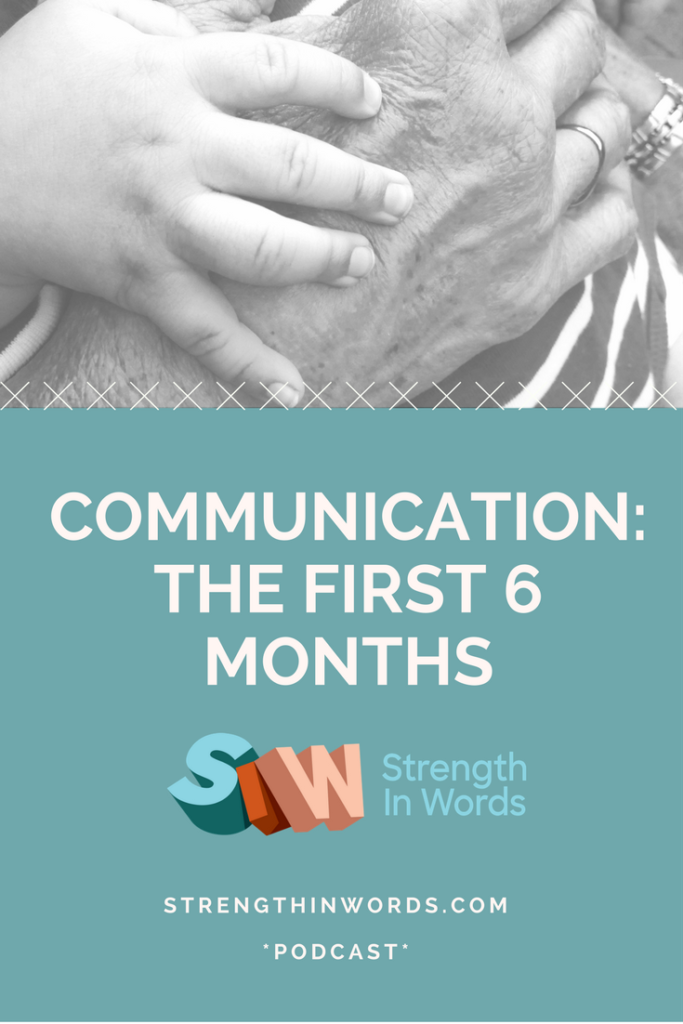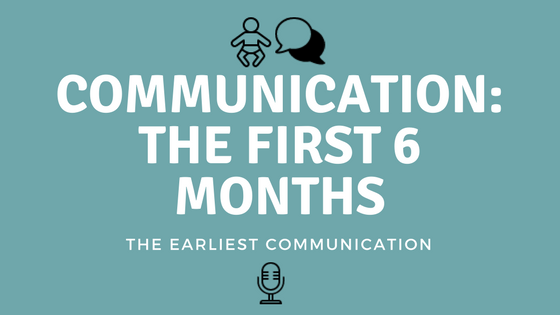Even in the first 6 months of life, there are communicative milestones through which infants move.

This episode of Learn With Less is focused on those wonderful, intense and amazing first 6 months of an infant’s life – and the parts of communicative development about which it helps to become aware!
Below is the transcript of this episode’s “Developmental Thought,” an excerpt from the full episode.
For additional information, music, play ideas and the complete interactive family experience, please listen to the entire episode.
Today, I want to talk about a few of the very early parts of communication development – those that typically happen in around the first 6 months of our babies’ lives.
There is so much that happens in that first year of life, in all areas of our infants’ learning.
>>Don’t Miss Our Corresponding Blog Post!<<
From Blob to Bub
Our babies grow from tiny (let’s face it, adorable blob-like) beings to tiny people starting to express their personalities, desires, and interests. In recent years, there’s been a real push to help parents and caregivers become more aware of “developmental milestones” – I very much encourage you to be aware of the basic things to look for, but I want to highlight also that obsessing over each milestone is not necessarily conducive for healthy support of our children’s learning, either!
It’s more about the whole picture. Also, there is always a range of “what’s normal.” If you are the parent of an infant who has come into this world under more challenging circumstances than others, or you are concerned that your child is not communicating the way you see other same-aged children doing, I encourage you to talk to your child’s medical provider or developmental specialist to gather more information.
Knowledge is power, and the more information you can collect – about your child’s hearing ability, about therapeutic techniques you or a specialist can do to help stimulate your child’s communication skills – the more your child can benefit!
Major Changes At 6 Weeks
We touched upon the earliest form of purposeful communication, crying. Interestingly, around 6 weeks is also when we start to see what’s known as a “social smile,” or an intentional smile… yes, grown-ups, sorry to disappoint, but in the early days and weeks after birth, you may have seen your baby turn her mouth upwards, seemingly smiling… though this is beautiful to witness and a nice preview, it is most likely your precious one making a slight effort to pass gas.
I think many of us feel, when that first real interactive smile comes, that this was SO necessary – because up until that point, we’ve essentially been slaves to this beautiful and wondrous tiny being, not sleeping, rarely eating or bathing, and there hasn’t been a whole lot of reciprocation. And then, those lips turn up… and wow. Thank you!
What’s fascinating is that that 6-8-week mark when you see that first social smile and when your baby realizes that if she cries, you will help her – it comes at around the same time… indicating that around this time, your baby is starting to make connections about human behavior!
She realizes that returning your smile keeps your attention! This is another wonderful early step in back-and-forth communication, and can be a great way to development of her self-esteem, as smiling back lets your baby know her feelings are important.
Cooing Begins
I mentioned earlier that in the first 3 months, the sounds your baby makes are mostly uncontrolled. Around the 4-month mark, clear vowel sounds start to emerge. This is when you start to hear those lovely “ah-ooo” pleasure sounds that are so sweet.
Vowels are open sounds, that don’t require a whole lot of specific tongue placement. They are all in the mouth shape (eeee, ooooo, aaaah), and therefore, the most obvious to imitate!
Vocal Play
The next step in this “vocal progression” (which, I’ll just say, is not a simple hand-off between one to the next! It will more likely be much more fluid than that), happens as your baby starts to play more with the sounds she is able to make, and that she sees and hears you making. You might see her purposefully playing with the flow of air through her lips as she makes raspberries (bbbbpppfff)…
The more “speech-like” vocal play includes both vowels as well as consonants, and is called babbling. You might hear your baby start to babble anytime between the ages of 4 – 10 months. Usually, babbling starts as what’s called “reduplicated babbling” – meaning that your baby may start to say “ma” and then “mamamamama.” These sounds are not yet considered words – though you may hear “mama” or “dada” or “papa.”
Your baby’s environment (as in, you!) starts to encourage production of these sounds – as in, you reinforce your baby when you hear her make various sounds, and as time moves on, she starts to babble not just to stimulate herself because it’s fun and feels good, but for a social purpose – when she “speaks,” she gets reinforced by you.
Those first consonants that you often hear are also /m/, /b/, /p/, /w/ – those that are formed on the lips (known in the linguistic world as “bilabials”) – though you may also hear others that are made toward the front of the mouth, with the tongue pressing on the ridge behind the front teeth like /d/ or /t/ (these are pressing on the alveolar ridge, and are therefore known as “alveolars”).
It makes one wonder which came first – the babbling of “mama, dada, papa” or the fact that those names are almost universally the same in so many languages? Fascinating stuff for any of you linguistic or child development nerds out there!
Role of Hearing
So, wow – all that happening by around 6 months… Now, again, I want to reiterate that if your infant is not exhibiting these communication behaviors within the timeframe that I spoke about in this episode, you are encouraged to discuss it with your child’s medical provider.
Hearing is also a huge factor in all of this – if a child is unable to hear the sounds around her, she will be unable to imitate them. That goes for both hearing loss, fluid in the ears, and also a child who is so uncomfortable or sick that she is crying and cannot hear or attend to her caregivers. It takes a village, as they say, and the medical community’s job is to be there to support families!

